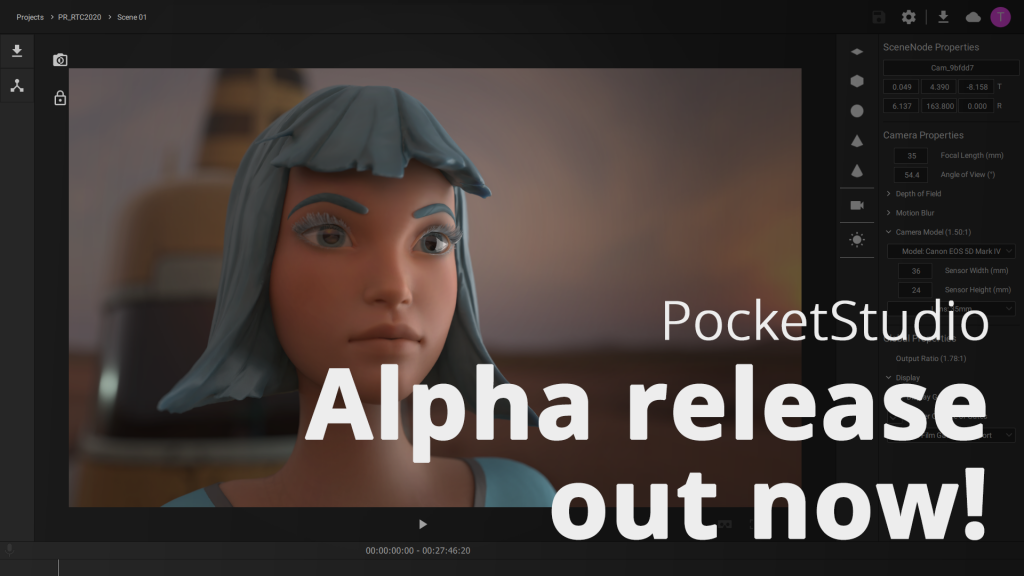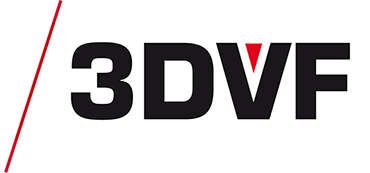This article is also available in:
French
In 2018, we published an article about the first public demo at SIGGRAPH. The team made a few bold statements : PocketStudio, they claimed, could revolutionize the way artists create and allow team to work together, in real-time, on a 3D scene. Basically, something similar to Google Documents, but for computer graphics.
Two years later, PocketStudio can be downloaded for free in alpha version. At this occasion, we interviewed the team behind PocketStudio in order to get a better idea of what can be done with this tool.
Is PocketStudio the beginning of a revolution ? Here are a few details to help you decide by yourself.

3DVF: Hello PocketStudio! We discovered your solution two years ago, during a SIGGRAPH 2018 presentation… For those who missed it, can you remind us the concept of your solution?
Jean-Colas Prunier, founder & CEO of PocketStudio: Hello 3DVF readers. PocketStudio is a collaborative real-time 3D software that brings together many of the tools needed to create 3D animation content in a single tool. In particular, it allows you to progress from layout to assembly in a single real-time workflow. This type of multi-function software is similar to a video game engine, but the difference between PocketStudio and game engines is that it is specifically designed for animation and film artists, so it is easy to use for this category of users.
“from layout to assembly
in a single real-time workflow”
PocketStudio is also natively collaborative: several people can work on the same project at the same time remotely and in real-time. As soon as you start PS, the application connects to the cloud, where the project data that is saved on the PC is also stored. It’s a kind of Google Docs for 3D animation. It is the precursor of a new generation of animation tools: real-time, multi-function, collaborative.
3DVF: PocketStudio’s approach basically evokes that of Minecraft servers, or a Google Doc as you just mentioned: a group of people collaborating, acting at the same time on different elements of a project… How did you come up with the idea of using this approach for professional 3D creation?
We created PocketStudio to solve two production problems. In response to a need to work in an “agile” way during the development phase of a film in particular. We needed a solution that would allow us to work on any aspect of a film in real time, such as changing the position of a camera in a scene and see the result of that change in real time in the edit without interruption. We also wanted a solution that would allow us to produce TV series much faster than we can today. The main reason why we have these two problems is the burden and the segmented and sequential nature of our current production pipelines. They are adapted to produce the three thousand shots of an Avatar, but unsuitable for the needs I mentioned. We had tested video game engines and came to the conclusion that they had good qualities but that we could go much further in terms of productivity gains and creativity with a tailor-made solution for animation; as this solution didn’t exist in 2017 and software publishers like Autodesk didn’t seem to be making any headway, we decided to create it.
3DVF : And is the result up to your expectations?
Let’s imagine that you have a sequence with several shots and you want to change the timing, the animation and the camera of shot 3 to adapt it to a new animation. This change will surely have an impact on shot 2 and 4. In a traditional pipeline you have to load the scene, load the animation (let’s assume the animation is provided), reposition the camera, re-render the scene, save the scene, do the same for the other two shots, then run Avid Media Composer and update your edit with the three new clips. It’s maybe ten minutes of work (or maybe more depending on the rendering) per shot, so maybe thirty minutes in total plus editing, perhaps thirty-five. In PocketStudio, you load the animation, reposition the three cameras and update your sequence with the new timing of the three shots. That is to say five minutes of work as much. In single-user mode, you are already at least seven to eight times faster. I let you imagine in collaborative mode! A movie is not a race against time. It’s not about being the fastest. But what’s important here is that you can do seven times as many iterations at the same time, so you have many more opportunities to explore ideas that can improve the narrative quality of your film. Maya and Blender have 3D editing tools but they only allow you to work on one scene at a time.
Another example: a colleague recently told me that the studio where he works, which is one of the three largest animation studios in the world, spent more than ten months on a camera that did not satisfy the director. They finally put a virtual camera in the director’s hands like the one in PocketStudio on a cell phone, except that in this case it was a multi-million dollar mocap system; he made his camera in ten minutes. PocketStudio’s virtual camera system only costs the price of the phone. And what’s even better with PocketStudio is that since the application is collaborative, the director can do it in real-time thousands of miles away from where the production team is located.
These two examples are extreme but demonstrate that the integrated real-time collaborative pipeline approach, pioneered by PocketStudio, does indeed lead to significant gains in creativity and productivity. I think these two examples alone justify the existence of the solution.
3DVF : you have just launched an alpha version: what does it allow you to do, and what are its limits?
This first version allows to test this concept of an intuitive workflow to create 3D scenes and edit them in the same tool, even if the scene and sequence editor are still basic. It is already possible to import animations, create lights, place cameras and edit the film in real time. Of course to share the project with anyone in just a few clicks (the data are also saved in the cloud, so a simple username is enough). Although it is young, the solution is already very powerful. PocketStudio also uses the RTX rendering technology developed by NVIDIA: with a single keystroke the viewport rendering changes to photographic quality (but you need an RTX-enabled NVIDIA GPU for this). RTX accelerates the simulation of light and camera effects such as depth of field, motion blur etc. on the GPU in a physically correct way. PocketStudio’s collaborative mode makes it possible to share projects with anyone but also to access project data from any device, whether it is another PC or a cell phone. Next to the PC application, we have developed a mobile application that allows you to access the scenes of a project to film them in augmented reality.
3DVF : What is your target audience?
Anyone who makes 3D animation. In its current version, PS still lacks key tools to produce TV series or layout efficiently. These developments are ongoing. But even in its alpha version, PS can be a great help. I see it a bit like a Swiss Army knife in 3D. We have users who already use it for its simplicity and rendering quality. We have a team whose animators and director live in different countries and use it to make animatics on short formats. It was the collaborative combo plus integrated workflow plus virtual camera on cell phone that appealed to them; imagine the complexity of working remotely on a film and the time wasted exchanging data.
“Collaborative + integrated workflow
+ virtual camera on a cell phone”
All this is solved by PS. A former colleague of Weta, now a VFX supervisor in Sweden, used it on a feature film project to prepare the shooting of the film with his team working from Romania. We also talk with architects. So a group of people with very different jobs but who have in common the need to have a turnkey solution that allows them to produce 3D content in a simple, fast and collaborative way.
Next page: the second part of the interview with questions about users management, roadmap, business model, NVIDIA Omniverse… And where to download PocketStudio!

